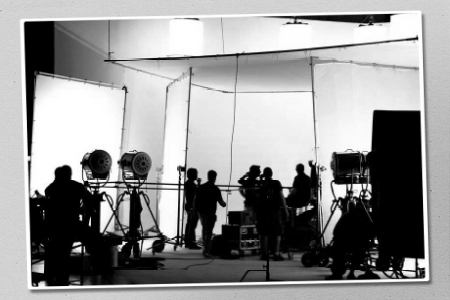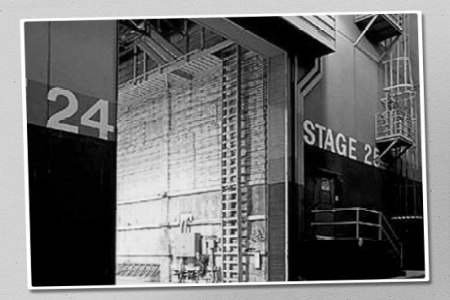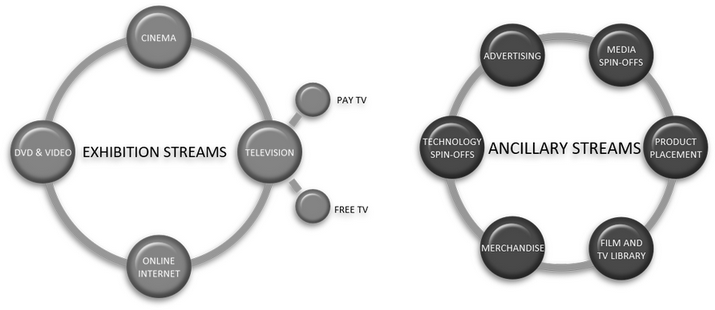



PRODUCTION PROCESS
Money | Talent | Facility | Networks | Profit
Introduction.
A successful limited television series production takes time and meticulous planning, starting off as just an idea to its release on a network. Each step requires a good balance between artistic flair and business acumen. From the production's official ‘green-light’ to its final delivery, the financial interests are a priority and are protected. The guarantee bond is a form of insurance offered by a completion guarantor company and is used to certify that the production will be finished, and delivered based on the final script, cast, and budget. If the film is not delivered, as per the agreed arrangement, then the guarantor will either, take over the production in order to complete the television series as per the original plan, or they will fully repay all sums contributed to the production.
Acquisition and Development.
The development stage takes the longest period of time within the production process. It includes acquiring the rights to a story idea, polishing the teleplay, finding the right talent (director, cast, and crew) and ultimately, sourcing and securing the production financing. Once a producer has acquired the rights to a book, play, treatment or teleplay, they work directly with a screenwriter, lending their experience to build on the concept and give it a ‘universal’ appeal. Teleplay development normally takes several months and involves many re-writes until the producer is satisfied with the tone and structure. During this phase, elements such as storylines, characterization, dialogue, and overall style are shaped. The final draft of the teleplay is polished in collaboration with the director, who in most cases is in charge of the visual and creative aspects of the production. When the teleplay is in its final form, the producer will prepare an appealing package for backers. This typically includes the polished teleplay, anticipated director, cast biographies and a financial plan to evaluate the commercial prospects of the project. Limited Television Series productions of a similar genre, from the same director or with the same cast may be cited as benchmarks. With the help of an illustrator, some television projects will see the director present a story board in order for studios or backers to pre-visualize and agree to the director’s vision of the finished product. Once the package has been thoroughly evaluated, the decision will be made whether to ‘pass’ on the limited television series project or green-light it by agreeing to be involved. A green-light status will progress a project almost immediately into the phase known as pre-production; to which, the production phase, will then follow based on the approved production schedule.
Secure Financing.
Understanding how to obtain production financing and their associated benefits is crucial to understanding the value that can ultimately be brought to studios or backers. Production companies may be entitled to some or all of the following resources, which should significantly reduce the commercial risk of any particular production. The precise amount available to a production company will vary from production to production by reference to the budget, the shooting location and the nature of the production itself.
Soft money.
National and regional Governments encourage investment into their respective television industries by creating incentive programs for producers. These grants and tax credits are broadly put in place to attract producers to shoot or complete post-production in these particular regions. These programs are created in return for promoting culture and tourism, as well as to develop economic growth in that region. Some conditions have to be met but they are largely systematic and the grants remain readily accessible. National or regional bodies do not usually expect any financial returns generated from the exploitation of the limited television series.
Private investment.
Most private investments represent an efficient way of investing into television through SEC Reg D 506b 4a2, private placement memorandum, accredited investors only. Mitigating risk is the key strategy used to secure private backing.
Pre-Sales.
The company will begin licensing the rights to exhibit the limited television series production within agreed territories once the teleplay has been polished and lead roles cast. Any territory sold before production starts is considered a ‘pre-sale’ and becomes a part of the television production financing structure. Networks usually pay the producer once the limited television series production has been delivered.
Deferments.
Producers, along with some key cast and crew members, can offer to defer their fees in order to reduce the amount of financing needed in order to start production. They will then be paid from gross receipts of the limited television series production generated on release.
Gap Loans.
This is the percentage of the total budget secured against the exhibition rights in the unsold territories around the world. This often covers the gap between the total budget and the financing provided by institutional equity, private equity, production tax credit incentives, and pre-sales.
Pre-Production & Production.
As soon as the producer has secured financing that reflects the total budget and stars are firmly attached, the project will become officially green-lit and can move into the phase after development known as pre-production. During this stage, the production office is established and the production crew is hired. It is in this phase when the teleplay officially becomes the shooting script and is broken down into individual scenes highlighting all of the important details (such as additional acting roles, locations, sets, stunts, props, costumes and even identifying any necessary post-production elements like visual effects) in order for the production to be scheduled and shot accordingly. Depending on the type of limited television series production being produced, the typical pre-production time period can range from 4 to 8 months before the commencement of principal photography, also known as the first day of production. In the production phase the director films the shooting script with the help of a vast production crew. During this time, the director sets the tone and pace of what goes on, in front of, and behind the camera. The typical production time period can range from about 8 to 12 months, but the schedule can vary depending on the type of episodes being produced. When principal photography is complete, the production normally takes about 4 weeks to wrap-up. This is when the crew strikes the set, packs up the production office, returns the rental equipment and puts everything owned into storage until it is needed for the producer’s next production. The marketing of the film can begin at any point throughout the production phase. The company will offer the rights in order to sell them in various territories, will come up with a networks who will market and exploit their plan to ensure their target audience is aware of the upcoming limited television series production at the earliest stage possible. The networks will have access to photos taken by an on-set stills photographer and recently shot scenes of the series, which they will use in order to strategically piece together a trailer or preview for promotional purposes.
Post Production.
As soon as principal photography has commenced the editing process can begin almost immediately after. Nowadays, using highly evolved digital photography technology, the editor can start piecing together the project’s footage right after it has been shot, transferred and properly logged into their editing system. The editor will roughly put together each scene, in tandem with the production, in order to present the director with the best takes and options for when the director is no longer on set and principal photography is complete. Once the project has wrapped it officially enters the post-production phase and the editor now has the full attention of the director in order to collaborate and finalize the director’s cut. Once the director’s cut is complete, the producer and network then step in and make any revisions, if necessary, to ensure that the series satisfies the original creative vision and will maintain its appeal to the intended target market audience. After they have agreed on the final version, the picture is locked and the final stages of post-production can now come into play. The visual effects and animation elements are created and implemented into the series by the Visual Effects editor, or Computer Graphic Imaging artists. Music and sound effects are added at the very end in order to properly match them to the final picture. The creative aspects of these final stages are driven by the director’s vision but the producer and network decide if anything needs to be changed before the series is released.
Networks.
Once complete, the network will begin to market the limited television series around the world. Networks are key to getting the series out to an audience as they have the infrastructure and knowledge to maximize the penetration of the series in their territory. A network will spend a certain amount of money on promoting the limited television series in its territory based on their agreement with the producer. The ultimate goal is to have the limited television series production screened to audiences on television networks worldwide; however, the format in which the audience is reached has evolved over the last decade and networks have systematically evolved alongside with it. This evolution, along with various new technologies, helps a limited television series generate revenue through multiple forms of licenses either simultaneously or consecutively to the limited television series broadcat or streaming release.

Home Entertainment.
This includes DVD and Blu-Ray sales and rentals, as well as online streaming and digital downloads. Home entertainment is the most diverse distribution format and allows distributors to explore new avenues in order to maintain consistent and healthy growth prospects.
Ancillary Rights.
There are many other revenue streams that exist that can have a highly positive impact on the television or film production's gross revenue. Ancillary rights can be broadly defined but always includes items such as merchandising rights and rights sold to airlines to screen films in-flight.

TM & Copyright 2024 Magnificent Pictures LLC. All rights reserved.